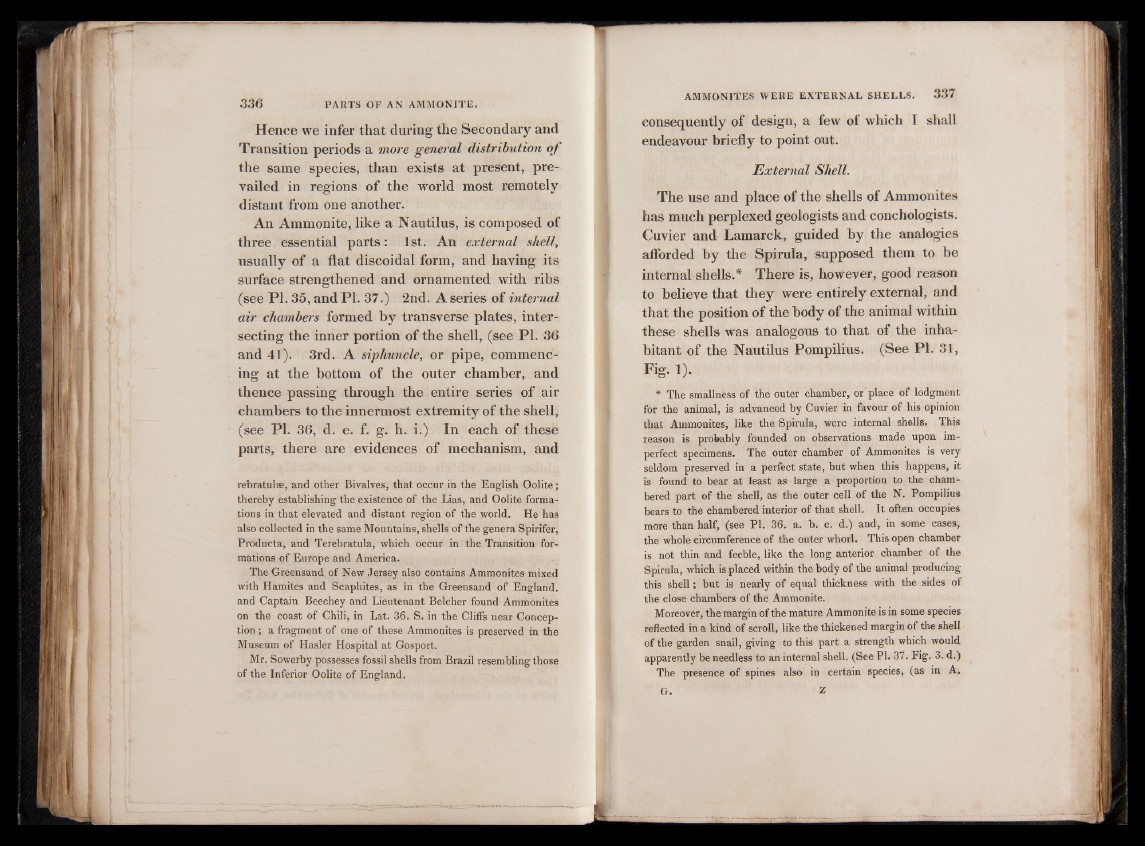
Hence we infer that during the Secondary and
Transition periods a more general distribution o f
the same species, than exists at present, prevailed
in regions of the world most remotely
distant from one another.
An Ammonite, like a Nautilus, is composed of
three essential parts: 1 st. An external shell,
usually of a flat discoidal form, and having its
surface strengthened and ornamented with ribs
(see PL 35, and PI. 37.) 2nd. A series of internal
air chambers formed by transverse plates, intersecting
the inner portion of the shell, (see PI. 36
and 41). 3rd. A siphuncle, or pipe, commencing
at the bottom of the outer chamber, and
thence passing through the entire series of air
chambers to the innermost extremity of the shell,
(see PI. 36, d. e. f. g. h. i.) In each of these
parts, there are evidences of mechanism, and
rebratulse, and other Bivalves, that occur in the English Oolite;
thereby establishing the existence of the Lias, and Oolite formations
in that elevated and distant region of the world. He has
also collected in the same Mountains, shells of the genera Spirifer,
Producta, and Terebratula, which occur in the Transition formations
of Europe and America.
The Greensand of New Jersey also contains Ammonites-mixed
with Hamites and Scaphites, as in the Greensand of England,
and Captain Beechey and Lieutenant Belcher found Ammonites
on the coast of Chili, in Lat. 36. S. in the Cliflfs near Conception
; a fragment of one of these Ammonites is preserved in the
Museum of Hasler Hospital at Gosport.
Mr. Sowerby possesses fossil shells from Brazil resembling those
of the Inferior Oolite of England.
AMMONITES WERE EXTERNAL SHELLS. 337
consequently of design, a few of which I shall
endeavour briefly to point out.
External Shell.
The use and place of the shells of Ammonites
has much perplexed geologists and conchologists.
Cuvier and Lamarck, guided by the analogies
afforded by the Spirula, supposed them to be
internal shells.* There is, however, good reason
to believe that they were entirely external, and
that the position of the body of the animal within
these shells was analogous to that of the inhabitant
of the Nautilus Pompilius. (See PL 31,
Fig. I).
* The smallness of the outer chamber, or place of lodgment
for the animal, is advanced by Cuvier in favour of his opinion
that Ammonites, like the Spirula, were internal shells. This
reason is probably founded on observations made upon imperfect
specimens. The outer chamber of Ammonites is very
seldom preserved in a perfect state, but when this happens, it
is found to bear at least as large a proportion to the chambered
part of the shell, as the outer cell of the N. Pompilius
bears to the chambered interior of that shell. It often occupies
more than half, (see PI. 36. a. b. c. d.) and, in some cases,
the whole circumference of the outer whorl. This open chamber
is not thin and feeble, like the long anterior chamber of the
Spirula, which is placed within the body of the animal producing
this shell; but is nearly of equal thickness with the sides of
the close chambers of the Ammonite.
Moreover, the margin of the mature Ammonite is in some species
reflected in a kind of scroll, like the thickened margin of the shell
of the garden snail, giving to this part a strength which would
apparently be needless to an internal shell. (See PL 37. Fig. 3. d.)
The presence of spines also in certain species, (as in A.
G. Z